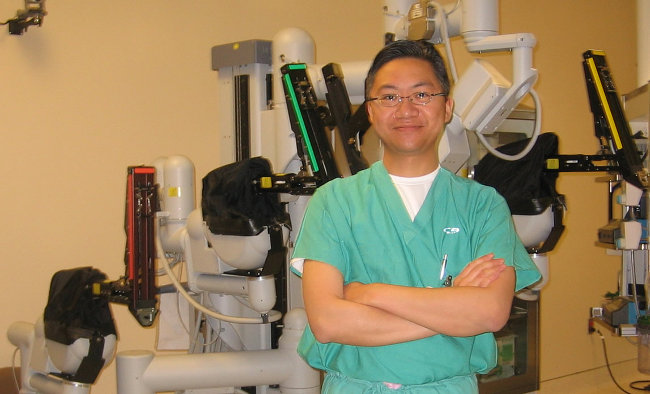The da Vinci Surgical System is a sophisticated robotic platform designed to enable complex surgery using a minimally invasive approach. The da Vinci System consists of an ergonomic surgeon’s console, a patient-side cart with four interactive robotic arms, a high-performance 3D HD vision system and proprietary EndoWrist® instruments. Powered by state-of-the-art robotic technology, the da Vinci System is designed to scale, filter and seamlessly translate the surgeon’s hand movements into more precise movements of the EndoWrist instruments. The net result is an intuitive interface with breakthrough surgical capabilities.
The da Vinci Surgical System’s main features include Intuitive® motion, high-resolution 3D vision and innovative EndoWrist instrumentation. Intuitive motion refers to the System’s interface, which helps make da Vinci surgery look and feel like traditional “open” surgery. But this is where the similarities end.
The da Vinci System’s high-resolution 3D stereo viewer is designed to provide surgeons with an immersive experience. Unlike conventional approaches, the target anatomy appears at high magnification, in brilliant color and with natural depth of field. To perform a procedure, the surgeon uses the console’s master controls to maneuver the patient-side cart’s four robotic arms, which securely hold the patented EndoWrist instruments and high-resolution endoscopic camera. The EndoWrist instruments’ jointed-wrist design exceeds the natural range of motion of the human hand; motion scaling and tremor reduction further interpret and refine the surgeon’s hand movements. A final hallmark of the da Vinci System is its fail-safe design, incorporating multiple, redundant safety features designed to minimize opportunities for human error when compared with traditional approaches.

By providing surgeons with superior visualization, enhanced dexterity, greater precision and ergonomic comfort, the da Vinci Surgical System makes it possible for more surgeons to perform minimally invasive procedures involving complex dissection or reconstruction. This ultimately raises the standard of care for complex surgeries, translating into numerous potential patient benefits.
For the patient, a da Vinci procedure can offer all the potential benefits of a minimally invasive procedure, including less pain, less blood loss and less need for blood transfusions. Moreover, the da Vinci System can enable a shorter hospital stay, a quicker recovery and faster return to normal daily activities. Clinical studies also suggest that the da Vinci System may help surgeons provide better clinical outcomes than conventional technologies allow – for example, better cancer control and a lower incidence of impotence and incontinence with da Vinci Prostatectomy.
Cancer control is defined in part by margin rates and PSA test scores. The following studies provide support for these claims: Badani KK, Kaul S, Menon M. Evolution of robotic radical prostatectomy: assessment after 2766 procedures. Cancer. 2007 Sep 24;110(9):1951-1958. Menon M, Shrivastava A, Kaul S, Badani KK, Fumo M, Bhandari M, Peabody JO. Vattikuti Institute prostatectomy: contemporary technique and analysis of results. Eur Urol. 2007 Mar;51(3):648-57; discussion 657-8. Epub 2006 Nov 3. Patel VR, Thaly R, Shah K. Robotic radical prostatectomy: outcomes of 500 cases. BJU Int. 2007 May;99(5):1109-12. Ahlering TE, Skarecky D, Borin J. Impact of cautery versus cautery-free preservation of neurovascular bundles on early return of potency. 1: J Endourol. 2006 Aug;20(8):586-9. Menon M, Kaul S, Bhandari A, Shrivastava A, Tewari A, Hemal A. Potency following robotic radical prostatectomy: a questionnaire based analysis of outcomes after conventional nerve sparing and prostatic fascia sparing techniques. J Urol. 2005 Dec;174(6):2291-6, discussion 2296.Borin JF, Skarecky DW, Narula N, Ahlering TE. Impact of urethral stump length on continence and positive surgical margins in robot-assisted laparoscopic prostatectomy. 1: Urology. 2007 Jul;70(1):173-7. Ahlering TE, Woo D, Eichel L, Lee DI, Edwards R, Skarecky DW. Robot-assisted versus open radical prostatectomy: a comparison of one surgeon’s outcomes. Urology. 2004 May;63(5):819-22. Menon M, Tewari A, Peabody JO, Shrivastava A, Kaul S, Bhandari A, Hemal AK. Vattikuti Institute prostatectomy, a technique of robotic radical prostatectomy for management of localized carcinoma of the prostate: experience of over 1100 cases. Urol Clin North Am. 2004 Nov;31(4):701-17. Tewari A, Srivasatava A, Menon M; Members of the VIP Team. A prospective comparison of radical retropubic and robot-assisted prostatectomy: experience in one institution. BJU Int. 2003 Aug;92(3):205-10.



